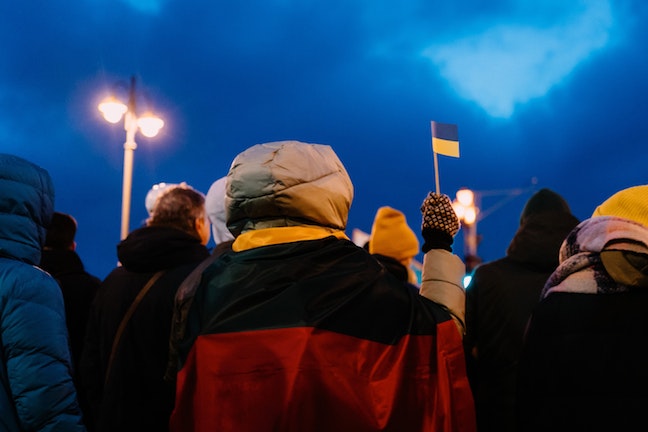Russia-Ukraine war: Key things to know about the conflict
Published 8:55 am Thursday, March 17, 2022

- Lithuanians protesting agains Russian invasion of Ukraine. (Photo: Dovile Ramoskaite/UnSplash)
Russia’s invasion of Ukraine entered its fourth week on today, with Russian forces largely bogged down outside major cities and shelling them from a distance, raining havoc on civilians.
The governor of the northern city of Chernihiv said it has experienced “colossal losses and destruction” from Russian artillery and air strikes. Viacheslav Chaus told Ukrainian TV on Thursday that the bodies of 53 people had arrived at city morgues over the past 24 hours.
In the besieged southern city of Mariupol, a Russian airstrike hit a theater where hundreds of people were sheltering. Ukrainian officials said the building withstood the impact but the entrance was blocked by rubble, and that some people had escaped. It was not yet known if there were casualties.
Trending
The strike came as Ukrainian President Volodymyr Zelenskyy invoked 9/11 during an urgent appeal to the U.S. Congress for more weapons to stem the Russian assault. U.S. President Joe Biden announced an additional $800 million for Ukraine’s military and said Russian President Vladimir Putin is a “war criminal.”
Putin meanwhile lashed out at “scum and traitors,” signaling an even harsher crackdown on domestic opposition to the war.
The fighting has led more than 3 million people to flee Ukraine, the U.N. estimates. The death toll remains unknown, though Ukraine has said thousands of civilians have died.
Here are some key things to know about the conflict:
WHAT IS HAPPENING ON THE GROUND?
“Several hundred” residents were sheltering in Mariupol’s Drama Theater when it was hit Wednesday, Pavlo Kyrylenko, the head of the Donetsk regional administration, wrote on Telegram. He said the airstrike also hit the Neptune swimming pool complex, burying women and children.
Trending
Satellite imagery from the Maxar space technology firm showed the word “CHILDREN” written in large white letters in Russian outside the theater building as recently as Monday.
The Russian Defense Ministry denied bombing any targets in Mariupol on Wednesday.
A fire broke out in an apartment building in the capital, Kyiv, early on Thursday after it was hit by the remnants of a downed Russian rocket, killing one person and injuring at least three others, according to emergency services.
Fighting continued in Kyiv’s suburbs, depriving thousands of heat and clean water.
In Chernihiv, the governor said civilians were hiding in basements and shelters without access to utilities in the city of 280,000 people. Close to the borders with Belarus and Russia, Chernihiv was among the first Ukrainian cities to come under attack when the invasion began on Feb. 24.
Britain’s Defense Ministry said Russia’s invasion “has largely stalled on all fronts” amid stiff Ukrainian resistance. It said Russian forces have made “minimal progress” on land, sea or air in recent days, and are suffering heavy losses.
Ukrainian forces are using inexpensive Turkish-made drones to carry out lethal attacks on the Russian invaders.
WHAT HAS THE AP DIRECTLY WITNESSED OR CONFIRMED?
In Mariupol, workers risked their own lives, braving relentless shelling to dump the bodies of children in a mass grave. Local officials have tallied 2,500 deaths in the siege, but many bodies crushed in the rubble can’t be counted because of the assault.
Bodies lie out in the street. Workers tell families to leave their dead outside because it’s too dangerous to hold funerals.
In Kharkiv, doctors are struggling to treat COVID-19 patients as the bombs fall outside. Several times a day, air raid sirens wail at a local hospital, sending virus patients — some connected to ventilators and struggling to breathe — into bomb shelters.
“Bombing takes place from morning into night,” hospital director Dr. Pavel Nartov said. “It could hit at any time.”
WHAT DETAILS HAVE EMERGED FROM NEGOTIATIONS BETWEEN RUSSIA AND UKRAINE?
Zelenskyy’s adviser Mikhailo Podolyak said Ukraine is demanding a cease-fire, the withdrawal of Russian troops and legal security guarantees for Ukraine from a number of countries. Ukrainian and Russian delegations held talks again Wednesday by video.
Another official in Zelenskyy’s office, speaking on condition of anonymity because of the sensitivity of the talks, said the main subject under discussion was whether Russian troops would remain in separatist regions in eastern Ukraine after the war and where the borders would be.
Just before the war, Russia recognized the independence of two regions controlled by Russian-backed separatists since 2014 and extended the borders of those regions to areas Ukraine had continued to hold, including Mariupol.
HOW IS THE WORLD RESPONDING TO THE WAR?
Six Western nations have called for a U.N. Security Council meeting on Ukraine on Thursday. The United Kingdom’s U.N. Mission tweeted Wednesday that “Russia is committing war crimes and targeting civilians. Russia’s illegal war on Ukraine is a threat to us all.”
The mission said the meeting was requested by six Security Council members and posted their flags — Britain, the U.S., France, Ireland, Norway and Albania.
It has not yet been officially scheduled.
Zelenskyy acknowledged in his speech to the U.S. Congress that the no-fly zone may not happen. Still, he said the U.S. must sanction Russian lawmakers and block imports, in addition to providing military assistance.
“We need you right now,” Zelenskyy said in remarks livestreamed to the U.S. Capitol, which were punctuated with a graphic video showing the grisly aftermath of the invasion.
Biden announced that the U.S. is sending an additional $800 million in military assistance — including anti-aircraft and anti-armor weapons and drones — to Ukraine, making a total of $2 billion in such aid sent to Kyiv since Biden took office more than a year ago.
Biden and China’s Xi Jinping are scheduled to speak by phone on Friday, and the U.S. president also plans to travel to Europe next week for talks with European leaders about the Russian invasion, and will attend an extraordinary NATO summit in Brussels. NATO has been bolstering its eastern flank with troops and equipment to deter Russia from invading any of its members.





